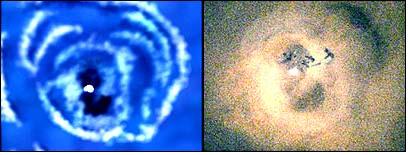Astronomers have detected sound waves emanating from a supermassive (supermassive) black hole. The "T" is the deepest ever discovered from an object in the universe.
Right: X-ray image of the Perseus star cluster by the Chandra telescope; Left: Sound waves cut through the hot gas
Direct link to this page: https://www.hayadan.org.il/soundblackhole.html
Astronomers have detected sound waves emanating from a supermassive (supermassive) black hole. The "T" is the deepest ever discovered from an object in the universe.
Sound waves cut through the hot gas
The black hole is found in the Perseus galaxy cluster, located about 250 million light years away. The amount of energy carried away from the black hole by these sound waves may solve a long open question in astrophysics. The pitch is measurable. Although they are too far away to hear. This is B FLAT (C flat and thanks to all the commenters. I learned from your comments)
Last year, the astronomers took a picture from the Chandra telescope that photographs the sky in the X-ray field, and in the picture the gas is seen filling the galaxy cluster.
According to the researchers these waves or rather ripples are evidence of sound waves moving hundreds of thousands of light years from the black hole in the center of the cluster.
However, there is no chance of hearing this "C flat" note, because it is 57 octaves below our hearing threshold. This is the deepest note ever heard in the universe.
"The sound waves from Perseus are much more than just an interesting type of black hole," says Steve Allen of the Institute of Astronomy in Cambridge, England. The sound waves may be key to trying to find how galaxy clusters, the largest structure in the universe, grow.
Astronomers still do not understand the process because there is so much hot gas in galaxy clusters and very little cold gas. The hot gas should cool and the compressed gas in the center should cool the fastest. Then the pressure in the cooled central gas should drop, causing the more distant gas to plunge toward the galaxy and create trillions of stars along the way, but that's not what we see.
The heating caused by the black hole is thought to be the reason why the gas does not cool. Previous images of the Perseus cluster showed two large, bubble-like fissures extending outward from the central black hole. Sound waves emanating from the center of these cracks may be a reaction of the warming mechanism.
The researchers calculated that a huge amount of energy is needed to create the fissures, equal to the energy of a hundred million exploding stars. Most of the energy may be found in the form of sound waves that keep the gas hot. If so, the intensity of these sound waves remains constant for at least 2.5 billion years.

